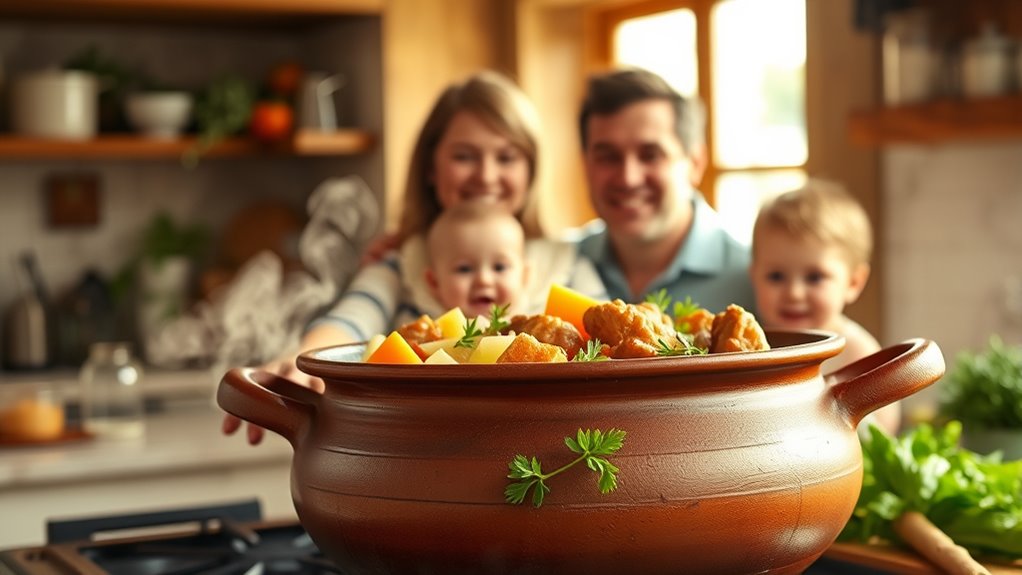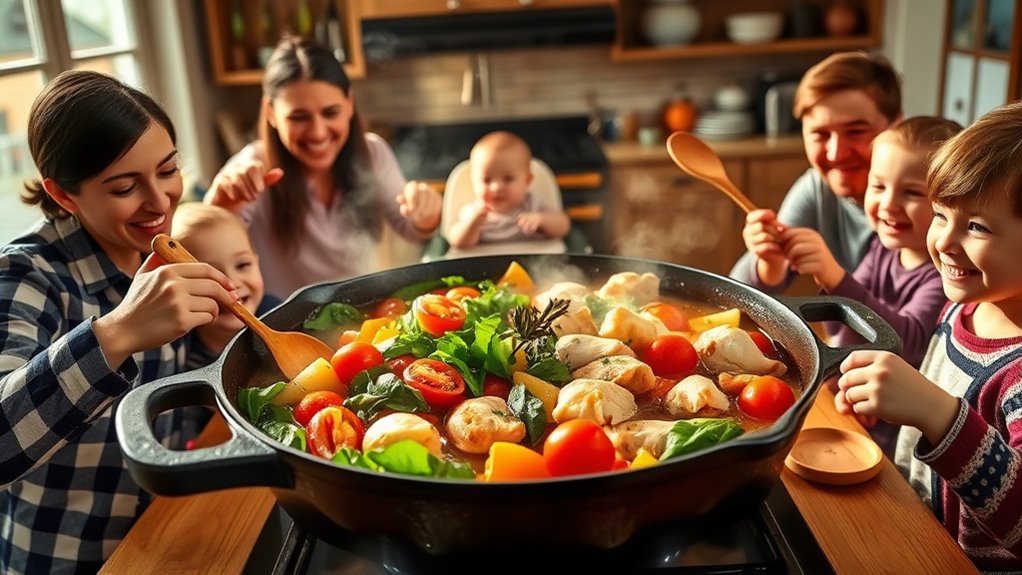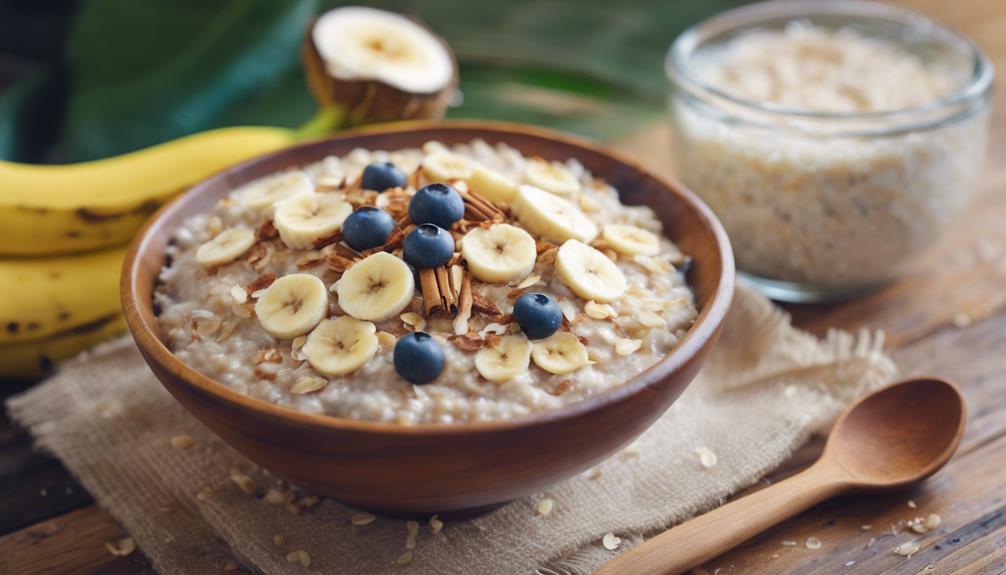One-pot family dinners make mealtime easier by combining ingredients into a single, nutritious dish that both you and your baby can enjoy. You can choose recipes that are adaptable to meet dietary needs, like adding hearty vegetables, grains, and gentle spices. Preparing ingredients in advance saves time and reduces stress. With flexible options, you can create meals everyone loves. Keep exploring to discover simple, inclusive recipes perfect for busy family nights.
Key Takeaways
- Use gentle, baby-friendly ingredients like soft vegetables, well-cooked grains, and mild flavors for safe, shared eating.
- Incorporate nutrient-dense foods such as pureed vegetables, beans, and wholesome proteins to suit both adults and babies.
- Opt for one-pot recipes with adjustable seasonings, allowing flavor modifications for family members of all ages.
- Choose recipes that avoid added salt and allergens, ensuring safety and inclusivity for babies and sensitive eaters.
- Prepare meals in advance with family-approved ingredients, making it easy to serve nourishing, shared dinners quickly.

Preparing a family dinner can often feel overwhelming, especially after a busy day. You’re juggling work, chores, and the needs of everyone in your household, all while trying to put a nutritious meal on the table. One-pot dinners are a game-changer, making meal prepping easier and cleaning up simpler. They allow you to combine ingredients into a single pot, saving you time and effort. Plus, they’re incredibly versatile, perfect for accommodating different dietary restrictions without creating multiple dishes. Whether someone needs gluten-free, dairy-free, or low-sodium options, you can tailor your recipes to fit everyone’s needs without extra fuss.
One-pot dinners simplify meal prep and accommodate dietary needs effortlessly.
When planning your one-pot family dinner, start by considering the dietary restrictions of your family members. If you have a vegetarian or vegan in the house, you can easily include hearty vegetables, beans, and plant-based proteins. For those on gluten-free diets, choose grains like rice, quinoa, or corn-based pasta instead of traditional wheat pasta. If someone is watching their sodium intake, skip the added salt and opt for herbs, spices, or low-sodium broth to flavor your dish. This way, you’re ensuring that everyone can enjoy the meal without feeling left out or restricted.
Meal prepping plays a big role in making these dinners work smoothly. You can prep ingredients ahead of time—chopping vegetables, marinating proteins, or measuring spices—so when it’s time to cook, everything comes together quickly. This not only saves time but also reduces the stress of last-minute cooking. With a well-organized prep, you can throw everything into your one pot, set it to cook, and focus on other tasks or spend quality time with your family. It’s a practical approach that keeps your dinner routine manageable, even during hectic weekdays.
Another benefit of one-pot dinners is how adaptable they are. If your child prefers milder flavors, you can keep their portion simple, while adding extra spices or heat for the adults. If someone has a food allergy, you can omit that ingredient entirely and substitute it with something safer. The beauty is that you don’t need to cook multiple dishes; just modify the ingredients or seasoning levels in the main pot. This flexibility makes one-pot dinners an excellent solution for busy families trying to balance health, taste, and convenience.
In the end, a one-pot family dinner isn’t just about saving time—it’s about creating a nourishing, inclusive meal that everyone can enjoy together. With some strategic planning, attention to dietary restrictions, and a little meal prepping, you can turn even the busiest evenings into a relaxed, satisfying family meal.
Frequently Asked Questions
Are These Recipes Suitable for Babies With Food Allergies?
You wonder if these recipes are suitable for babies with food allergies. It’s important to check allergy-friendly options and make ingredient substitutions to guarantee safety. You can swap out common allergens like dairy, eggs, or nuts with suitable alternatives. Always read labels carefully and consult your pediatrician before trying new ingredients. By customizing recipes, you can create safe, delicious meals that everyone in the family, including your little one, can enjoy.
Can I Prepare These Dinners Ahead of Time?
Think of meal prepping like planting seeds for busy days ahead. You can prepare these dinners in advance and store them for later, making freezer storage your best friend. Just guarantee you cool the dishes quickly, store them in airtight containers, and reheat thoroughly. This way, you get delicious, nutritious meals ready to serve without the daily scramble, saving time and keeping everyone happy and well-fed.
What Are Some Kid-Friendly Flavor Modifications?
When making these dinners kid-friendly, you can easily tweak the flavor by adjusting the seasoning and ingredient substitutions. Use milder seasonings like a touch of garlic powder or herbs instead of strong spices, and swap out spicy or unfamiliar ingredients for familiar ones like sweet potatoes or carrots. These seasoning adjustments and ingredient substitutions help make meals more appealing to little taste buds while keeping them nutritious.
How Do I Ensure the Meal Is Nutritionally Balanced?
To guarantee your meal is nutritionally balanced, focus on proper meal portioning and ingredient substitutions. Fill half your plate with vegetables, a quarter with lean proteins, and a quarter with whole grains. Use ingredient substitutions like swapping white rice for quinoa or adding extra vegetables to boost fiber and vitamins. This way, both you and your baby get essential nutrients, supporting healthy growth and energy.
Are These Recipes Appropriate for Infants Under 6 Months?
Sure, giving your tiny tot a one-pot wonder sounds adorable, but hold your horses! These recipes aren’t suitable for infants under 6 months because their delicate infant digestion can’t handle solid foods yet, and allergen concerns are high. Skip the spices, salt, and potential allergens, and wait until your baby is ready, usually around 6 months, to make certain of safety and proper development.
Conclusion
So, after all this fuss about perfect family dinners, who knew that the simplest one-pot meals could save you time, mess, and stress? You might think whipping up a fancy dish is necessary, but turns out, it’s the humble, easy-to-make recipes that bring everyone together—baby included. Irony? The more straightforward the dinner, the more you actually get to enjoy the moment. Now, isn’t that a delicious surprise?










